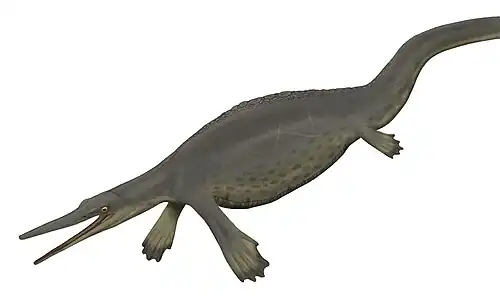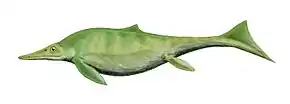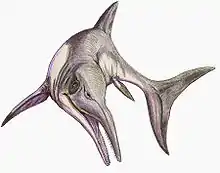| Shonisaurus Temporal range: Late Triassic (Carnian), | |
|---|---|
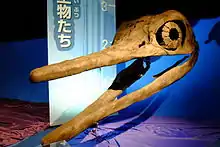 | |
| Restored skull in a Japanese museum | |
| Scientific classification | |
| Domain: | Eukaryota |
| Kingdom: | Animalia |
| Phylum: | Chordata |
| Class: | Reptilia |
| Order: | †Ichthyosauria |
| Family: | †Shastasauridae |
| Genus: | †Shonisaurus Camp, 1976 |
| Type species | |
| †Shonisaurus popularis Camp, 1976 | |
| Species[2][1] | |
| |
Shonisaurus is a genus of very large ichthyosaurs. At least 37 incomplete fossil specimens of the marine reptile have been found in the Luning Formation of Nevada, USA. This formation dates to the late Carnian age of the late Triassic period, about 237–227 million years ago.[1]
Description

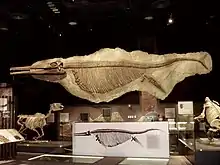
Shonisaurus lived during the Carnian stage of the late Triassic period. With a large skull about 2.75 m (9.0 ft) long, S. popularis and measured around 13.5–15 metres (44–49 ft) in length and 21.6–29.7 metric tons (23.8–32.7 short tons) in body mass.[3][4] S. sikanniensis was one of the largest marine reptiles of all time, measuring 21 metres (69 ft) and weighing 81.5 metric tons (89.8 short tons).[3]
Shonisaurus had a long snout, and its flippers were much longer and narrower than in other ichthyosaurs. While Shonisaurus was initially reported to have had socketed teeth (rather than teeth set in a groove as in more advanced forms), these were present only at the jaw tips, and only in the very smallest, juvenile specimens. All of these features suggest that Shonisaurus may be a relatively specialised offshoot of the main ichthyosaur evolutionary line.[5] More recent finds however indicate that Shonisaurus possessed teeth in all ontogenetic stages.[6] It was historically depicted with a rather rotund body, but studies of its body shape since the early 1990s have shown that the body was much more slender than traditionally thought.[7] S. popularis had a relatively deep body compared with related marine reptiles.[1]
Although it is not known if Shonisaurus had one, a more basal ichthyosaur Mixosaurus had a dorsal fin.[8]
History

Fossils of Shonisaurus were first found in a large deposit in Nevada in 1920. Thirty years later, they were excavated, uncovering the remains of 37 very large ichthyosaurs. These were named Shonisaurus, which means "lizard from the Shoshone Mountains", after the formation where the fossils were found.
S. popularis, was adopted as the state fossil of Nevada in 1984. Excavations, begun in 1954 under the direction of Charles Camp and Samuel Welles of the University of California, Berkeley, were continued by Camp throughout the 1960s. It was named by Charles Camp in 1976.[9]
The Nevada fossil sites can currently be viewed at the Berlin-Ichthyosaur State Park.
A second species from British Columbia was named Shonisaurus sikanniensis in 2004.[3] However, a phylogenetic study by Sander and colleagues in 2011 later showed S. sikanniensis to be a species of Shastasaurus rather than Shonisaurus.[10] A subsequent study by Ji and colleagues published in 2013 reasserted the original classification, finding it more closely related to Shonisaurus than to Shastasaurus.[11] Support for both hypotheses has been found in later studies, with some authors classifying the species in Shonisaurus and others in Shastasaurus.[12][13] Specimens belonging to S. sikanniensis have been found in the Pardonet Formation British Columbia, dating to the middle Norian age (about 210 million years ago).[1]
See also
- Largest prehistoric organisms
- Shastasaurus, a relative of and what used to be classified as a species of Shonisaurus
- Temnodontosaurus, another large ichthyosaur
- List of ichthyosaurs
- Timeline of ichthyosaur research
Notes
- 1 2 3 4 5 Nicholls, Elizabeth L.; Manabe, Makoto (2004). "Giant Ichthyosaurs of the Triassic—A New Species of Shonisaurus from the Pardonet Formation (Norian: Late Triassic) of British Columbia". Journal of Vertebrate Paleontology. 24 (4): 838–849. doi:10.1671/0272-4634(2004)024[0838:GIOTTN]2.0.CO;2. ISSN 0272-4634.
- ↑ McGowan, C.; Motani, R. (1999). "A Reinterpretation Of the Upper Triassic Ichthyosaur Shonisaurus". Journal of Vertebrate Paleontology. 19 (1): 42–49. doi:10.1080/02724634.1999.10011121.
- 1 2 3 Sander, P.M.; Griebeler, E.M.; Klein, N.; Juarbe, J.V.; Wintrich, T.; Revell, L.J.; Schmitz, L. (2021). "Early giant reveals faster evolution of large body size in ichthyosaurs than in cetaceans" (PDF). Science. 374 (6575): eabf5787. doi:10.1126/science.abf5787. PMID 34941418. S2CID 245444783.
- ↑ Sander, P.M.; Romero Pérez de Villar, P.; Furrer, H.; Wintrich, T. (2022). "Giant Late Triassic Ichthyosaurs from the Kössen Formation of the Swiss Alps and Their Paleobiological Implications" (PDF). Journal of Vertebrate Paleontology. 41 (6): e2046017. doi:10.1080/02724634.2021.2046017.
- ↑ Palmer, D., ed. (1999). The Marshall Illustrated Encyclopedia of Dinosaurs and Prehistoric Animals. London: Marshall Editions. pp. 78–79. ISBN 1-84028-152-9.
- ↑ Kelley, Neil P.; Irmis, Randall; Rasmussen, Cornelia; Depolo, Paige E.; Pyenson, Nicholas (2016). "BEYOND THE SHONISAURUS DEATH CULT: NEW INSIGHTS INTO THE ECOLOGY AND LIFE HISTORY OF THE EARLIEST GIGANTIC MARINE TETRAPOD". 76th Annual Meeting of the Society of Vertebrate Paleontology, Salt Lake City: 587. Retrieved 27 September 2021.
- ↑ Kosch, Bradley F. (1990). "A revision of the skeletal reconstruction of Shonisaurus popularis (Reptilia: Ichthyosauria)". Journal of Vertebrate Paleontology. 10 (4): 512–514. doi:10.1080/02724634.1990.10011833.
- ↑ Renesto, Silvio; Dal Sasso, Cristiano; Fogliazza, Fabio; Ragni, Cinzia (2020). "New findings reveal that the middle Triassic ichthyosaur Mixosaurus cornalianus is the oldest amniote with a dorsal fin". Acta Palaeontologica Polonica. 65. doi:10.4202/app.00731.2020. ISSN 0567-7920.
- ↑ Hilton, Richard P. (2003). Dinosaurs and Other Mesozoic Animals of California. University of California Press, Berkeley. pp. 90–91. ISBN 0-520-23315-8.
- ↑ Sander, P. Martin; Chen, Xiaohong; Cheng, Long; Wang, Xiaofeng (2011). Claessens, Leon (ed.). "Short-Snouted Toothless Ichthyosaur from China Suggests Late Triassic Diversification of Suction Feeding Ichthyosaurs". PLOS ONE. 6 (5): e19480. Bibcode:2011PLoSO...619480S. doi:10.1371/journal.pone.0019480. PMC 3100301. PMID 21625429.
- ↑ Ji, C.; Jiang, D. Y.; Motani, R.; Hao, W. C.; Sun, Z. Y.; Cai, T. (2013). "A new juvenile specimen of Guanlingsaurus (Ichthyosauria, Shastasauridae) from the Upper Triassic of southwestern China". Journal of Vertebrate Paleontology. 33 (2): 340. doi:10.1080/02724634.2013.723082. S2CID 83784699.
- ↑ Moon, B. (2019). "A new phylogeny of ichthyosaurs (Reptilia: Diapsida)". Journal of Systematic Palaeontology. 17: 1–27.
- ↑ Bindellini G; Wolniewicz AS; Miedema F; Scheyer TM (2021). "Cranial anatomy of Besanosaurus leptorhynchus Dal Sasso & Pinna, 1996 (Reptilia: Ichthyosauria) from the Middle Triassic Besano Formation of Monte San Giorgio, Italy/Switzerland: taxonomic and palaeobiological implications". PeerJ. 9 (e11179). doi:10.7717/peerj.11179. hdl:11573/1682932.
References
- Dixon, Dougal. "The Complete Book of Dinosaurs." Hermes House, 2006.
- Camp, C. L. (1980). "Large ichthyosaurs from the Upper Triassic of Nevada". Palaeontographica, Abteilung A. 170: 139–200.
- Camp, C.L. 1981. Child of the rocks, the story of Berlin-Ichthyosaur State Park. Nevada Bureau of Mines and Geology special publication 5.
- Cowen, R. 1995. History of life. Cambridge, Massachusetts: Blackwell Scientific.
- Hogler, J. A. (1992). "Taphonomy and Paleoecology of Shonisaurus popularis (Reptilia: Ichthyosauria)". PALAIOS. 7 (1): 108–117. Bibcode:1992Palai...7..108H. doi:10.2307/3514800. JSTOR 3514800.
- McGowan, Chris; Motani, Ryosuke (1999). "A reinterpretation of the Upper Triassic ichthyosaurShonisaurus". Journal of Vertebrate Paleontology. 19: 42–49. doi:10.1080/02724634.1999.10011121.
- Motani, Ryosuke; Minoura, Nachio; Ando, Tatsuro (1998). "Ichthyosaurian relationships illuminated by new primitive skeletons from Japan". Nature. 393 (6682): 255–257. Bibcode:1998Natur.393..255M. doi:10.1038/30473. S2CID 4416186.
